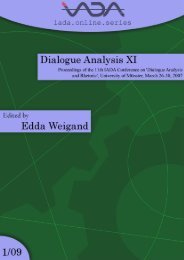Dialogue in and between Different Cultures - International ...
Dialogue in and between Different Cultures - International ...
Dialogue in and between Different Cultures - International ...
Create successful ePaper yourself
Turn your PDF publications into a flip-book with our unique Google optimized e-Paper software.
Contrastive Analysis of English <strong>and</strong> Polish Military Texts<br />
Anna Szczepaniak-Kozak<br />
Adam Mickiewicz University <strong>in</strong> Poznań, Pol<strong>and</strong><br />
The article aims at a comparison of contemporary English <strong>and</strong> Polish military texts of<br />
logistics. To conduct a contrastive analysis of such texts, some elements of de Beaugr<strong>and</strong>e<br />
<strong>and</strong> Dressler’s (1981) <strong>in</strong>teractive model of text <strong>and</strong> discourse process<strong>in</strong>g are<br />
applied, with the goal-plann<strong>in</strong>g <strong>and</strong> topicaliz<strong>in</strong>g levels of analysis as the most productive<br />
stages. It appears that although these two schools of writ<strong>in</strong>g are congruent <strong>in</strong> terms of<br />
the discussed subjects, <strong>in</strong>volved discourse participants <strong>and</strong> established term<strong>in</strong>ology,<br />
there exist differences as far as grammar <strong>and</strong> vocabulary structures are concerned, e.g.<br />
frequency of impersonal constructions <strong>and</strong> imperative mood constructions, use of<br />
metaphors, cases of pleonasms. The contrasted styles of writ<strong>in</strong>g differ also <strong>in</strong> terms of<br />
the text layout. However, although we cannot postulate that there is only one model of<br />
the written military language, we can observe numerous features which are shared by<br />
various texts exist<strong>in</strong>g with<strong>in</strong> this professional environment across languages.<br />
1. Introduction<br />
Any textual analysis of military texts constitutes a very elaborate <strong>and</strong> extensive<br />
research. For the purpose of study<strong>in</strong>g the military discourse the follow<strong>in</strong>g schools<br />
of thought seem very advantageous: (1) James Gee’s (2000:40-45) theory of<br />
situated identity, mean<strong>in</strong>g <strong>and</strong> cultural model together with his model of<br />
communication aspects, (2) Dell Hymes’ (1972) SPEAKING grid, <strong>and</strong> (3) M.A.<br />
K. Halliday’s (1994) study of functional grammar elements. However, the present<br />
paper presents the results of a research project conducted from a textual<br />
perspective ma<strong>in</strong>ly follow<strong>in</strong>g de Beaugr<strong>and</strong>e <strong>and</strong> Dressler’s (1997) ideas. Their<br />
approach is known under the name ‘<strong>in</strong>teractive model of text <strong>and</strong> discourse<br />
process<strong>in</strong>g’.<br />
2. Methodology<br />
When Pol<strong>and</strong> started its efforts to jo<strong>in</strong> the North Atlantic Treaty Organization, the<br />
Alliance laid down several conditions which our national military forces had to<br />
satisfy. One of them was adjust<strong>in</strong>g Polish regulations to those of already<br />
associated NATO countries. In fact, one of the reasons why the North Atlantic<br />
Treaty Organization operates so efficiently is that all member countries must<br />
adhere to the same pr<strong>in</strong>ciples <strong>and</strong> work accord<strong>in</strong>g to the same regulations.



